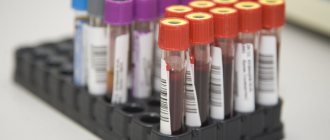The intestine consists of two sections: thin (with a diameter of 4 to 6 cm at the beginning and from 2.5 to 3 cm at the end) and thick (with a diameter of 4 to 10 cm). The total length of the intestine reaches 7-8 meters. Oncological diseases can develop in any of these departments. Depending on the location of the tumor, symptoms, treatment and diagnosis of colon cancer may differ. With timely detection and treatment, this disease has a favorable prognosis.
Early diagnosis of intestinal cancer is carried out at the Yusupov Hospital in Moscow. Thanks to modern diagnostic equipment and the vast experience of our specialists, maximum accuracy of research results is achieved.
Classification of bowel cancer
Colon cancer is a complex of oncological pathologies distinguished by the following features:
- the location of the tumor in the intestine: the main symptoms of the disease directly depend on the location of the primary tumor;
- histological type: the type of tumor is determined by the type of cells from which the primary neoplasm developed;
- the direction and nature of growth, the tendency to metastasize: these factors determine how quickly new symptoms and their list appear.
Metastases
In colorectal cancer, the liver is often the first site to metastasize. This occurs at the 4th stage of the disease. The prognosis of stage 4 intestinal cancer with metastases will depend on the degree of damage to tissues and organs. If you undergo treatment and follow the doctor’s recommendations, the patient can live for about 2 more years.
Metastases of stage 4 intestinal cancer can affect the retroperitoneal space and peritoneum, pelvic organs, pancreas, bladder, and lungs. Adverse symptoms of intestinal metastases will be as follows:
- Tumor growth into fatty tissue;
- Perforation of the colon;
- Spread of cancer cells to neighboring organs;
- The presence of cancer cells with a low degree of differentiation.
Primary signs of bowel cancer
Like many other oncological diseases, intestinal cancer in the initial stages manifests itself with subtle and subtle symptoms, which often go unnoticed:
- certain changes in intestinal motility;
- general weakness, fatigue, loss of body weight that does not have natural causes;
- anemia;
- the presence of blood in the stool;
- changes in taste preferences, the appearance of aversion to certain foods.
The presence of such signs and symptoms of bowel cancer, as a rule, does not cause concern for patients. This oncopathology in the early stages can be detected by chance, when the patient undergoes an endoscopic examination for a completely different reason. Most often, intestinal cancer is detected in late, advanced stages, requiring long-term and complex treatment.
Early diagnosis of colon cancer ensures timely initiation of treatment, which increases the patient’s chances of recovery and maintaining quality of life. Therefore, if you have at least one of the above signs of this disease, you must immediately consult a doctor and undergo a thorough examination.
Diagnosis and treatment of oncological diseases is carried out in one of the leading centers in Moscow - the Yusupov Hospital.
Detailed description of the study
Carcinoembryonic antigen (CEA) is a protein present in certain tissues of the developing fetus. By the time a child is born, its production is significantly reduced. CEA does not penetrate the placental barrier, so its content in the mother’s blood does not increase during pregnancy.
In adults, CEA is normally present in the blood in very low quantities. Men have, on average, slightly higher levels of this substance than women. Its production in the body increases sharply during certain oncological processes and inflammation.
CEA is not an antigen in relation to tissues and cells in the human body, but it has the ability to combine with antibodies during immunochemical analysis, that is, it exhibits antigenic properties.
These features of REA determine the name of this analysis. It is used as one of the tumor markers to detect cancer.
Assessment of the content of CEA in human blood is more often used for colorectal cancer, that is, damage to the colon and rectum, since for diseases of this localization it has a fairly high sensitivity.
This study is of greatest diagnostic value for people with already confirmed cancer and is used to assess the response to treatment and achieve remission.
In case of successful chemotherapy or surgery, CEA levels decrease within several months. Their repeated increase may indicate a relapse of the disease.
An isolated increase in CEA serves as an auxiliary tumor marker for malignant tumors of many locations. However, an increase in CEA in the absence of clinical and laboratory-instrumental data on the presence of cancer does not necessarily mean that any organ is affected by cancer.
An increase in CEA production is observed with inflammation of the gastrointestinal tract and mammary gland. Long-term smoking doubles its concentration. Metabolism of this tumor marker is carried out in the liver, therefore, when it is damaged, CEA indicators are increased even in the absence of an oncological process.
Main symptoms of bowel cancer
The appearance of more significant signs of an intestinal tumor is noted as the tumor grows:
- the presence of blood is observed in the stool: both individual streaks and completely colored stool;
- the presence of pus and mucus is noted in the stool, causing an unpleasant odor in the stool;
- patients begin to worry about constipation, which is replaced by diarrhea;
- blood pressure decreases, the blanching of the skin disappears, and attacks of cold sweat occur periodically - when the tumor is localized in the cecum;
- development of nausea and vomiting, which does not bring relief and is accompanied by an increase in body temperature;
- the appearance of pain arising in the projection of the neoplasm onto the abdominal wall;
- feeling of incomplete bowel movement after defecation;
- long absence of bowel movements, which can last several weeks. The abdominal wall becomes hard and painful;
- Over time, general oncological symptoms develop and secondary tumors appear.
The manifestations of intestinal cancer depend on a number of factors, primarily on where the malignancy is localized.
How is bowel cancer treated?
Treatment for bowel cancer is complex. It includes surgery and subsequent chemotherapy, radiotherapy or radiation therapy, as well as rehabilitation. The many years of experience of oncologists at the Yusupov Hospital helps achieve optimal treatment effects even in the most difficult cases.
Treatment methods for bowel cancer are:
- Surgical intervention. The operation can be performed using the abdominal (open) method, as well as minimally invasive methods: endoscopy, laparoscopy, radiosurgery (gamma knife and cyber knife). The choice of treatment method will depend on the stage of the disease, the location of the tumor, and its size. The prognosis after surgery for intestinal tumors is significantly improved, since the likelihood of metastasis is reduced;
- Radiation and radiotherapy therapy for intestinal cancer. Prescribed to stop the growth of malignant cells and the progression of the disease. Can be used before and after surgery;
- Chemotherapy for colon cancer. Treatment uses a number of drugs that cause cancer cell death. These drugs also negatively affect healthy cells, which is why chemotherapy has many unpleasant side effects (hair loss, constant vomiting). To support the body, immunostimulants are prescribed in parallel.
With proper treatment, patients have a significantly increased chance of prolonging their lives.
Symptoms of small intestine cancer
The formation of cancerous tumors in the small intestine is quite rare, but such cases do occur. In such cases, the disease manifests itself with the following symptoms:
- dyspepsia: nausea, vomiting, intestinal spasms, pain in the epigastric region;
- lack of appetite, aversion to food, weight loss;
- intestinal bleeding, the main manifestation of which is the dark color of stool;
- intestinal obstruction – in the later stages of the disease;
- compression of nearby organs with the subsequent development of many severe symptoms: jaundice, ascites, pancreatitis, peritonitis.
When are tumor markers prescribed for stomach diseases?
Tumor markers can be prescribed by a gastroenterologist for precancerous diseases and neoplasms of the stomach - chronic atrophic gastritis, intestinal metaplasia of the stomach, polyps, adenomas, cysts and other gastric neoplasms detected during FGDS. Gastric cancer is the second most frequently diagnosed malignant disease of the gastrointestinal tract; it is often diagnosed in late stages.
Cancer antigen CA 72-4 is the most sensitive to the presence of tumors in the stomach. With an increase of 2-5 times or more relative to the norm (2-4.5 units/ml), there is a high probability of detecting stomach cancer. May sometimes be elevated to 7 units/ml in healthy people or in people with various diseases of the gastrointestinal tract.
Cancer antigen CA 19-9 is used as the main marker for diagnosing pancreatic cancer and as an additional marker for suspected gastric cancer. An increase of 3 or more times relative to the norm is important.
The cancer antigen CEA is used as the main marker for the diagnosis of colon cancer. It may also increase in cancer of the stomach, pancreas, breast, lungs, prostate, ovaries, therefore it is also used as an additional dose if gastric cancer is suspected. A tenfold increase relative to the norm is significant.
Use of tumor markers for stomach cancer:
- in the differential diagnosis of benign and malignant diseases;
- in combination with other indicators to identify the primary location of the tumor during metastasis;
- to monitor the effectiveness of treatment for stomach cancer;
- to assess the stage of the disease.
Symptoms of colon cancer
When the tumor is localized in one of the parts of the large intestine, the patient develops symptoms similar to small intestine cancer, but there are some differences. The development of colon cancer is characterized by the following manifestations:
- pain in the abdominal area: they can be quite long-lasting, dull and aching in nature;
- the presence of blood in the stool (as a rule, these are scarlet streaks, often mistaken by the patient for symptoms of hemorrhoids);
- loss of appetite, weakness, apathy, weight loss;
- periodic bloating, increased peristalsis;
- the presence of mucus and pus in the stool.
Colon cancer in the early stages most often occurs without characteristic signs or with vague symptoms. As the tumor develops, the symptoms worsen, and severe intestinal disorders occur.
Diagnosis of colon cancer
Given the hidden nature of the disease in the early stages of development, every person over 50 years of age should undergo regular preventive examination by a gastroenterologist, who will interview the patient in detail, examine and palpate the abdominal cavity. If there is a suspicion of a tumor, a stool test for occult blood and a general blood test are prescribed. If a specialist’s suspicions are confirmed, further examination is necessary.
You can specify the localization of the tumor and determine its size using the following diagnostic procedures:
- irrigoscopy - an X-ray examination of the intestines, involving the introduction of a contrast agent into the body through an enema, followed by visualization of the condition of the colon;
- sigmoidoscopy – partial examination of the intestines using a special device that is inserted into the patient’s anus;
- colonoscopy - a method similar to that described above, but allowing visualization of a longer section of the colon;
- biopsy - histological examination of a small fragment of the colon mucosa;
- analysis for tumor markers (for colorectal cancer) - blood diagnostics allows you to identify the degree of activity of the cancer process;
- ultrasound examination - a method that allows you to visualize the condition of the colon by inserting a sensor through the anus or abdominal cavity;
- PET-CT is the most sensitive research method for determining the location and size of the tumor and the extent of the cancer process in the body (metastasis process).
How to prevent colorectal cancer?
Rectal cancer can be avoided. The disease develops in the presence of long-existing polyps. Their appearance is asymptomatic, so in order to detect these benign formations in time, people after 45 years of age need to undergo a colonoscopy.
If during the examination the doctor finds polyps in the patient, he will be able to remove them painlessly. After such removal, the patient should undergo a colonoscopy annually to prevent the development of new polyps.
If no formations in the rectum are detected, colonoscopy can be repeated after 10 years. In the interval between these examinations, it is enough to do a blood culture test for occult blood from time to time.







